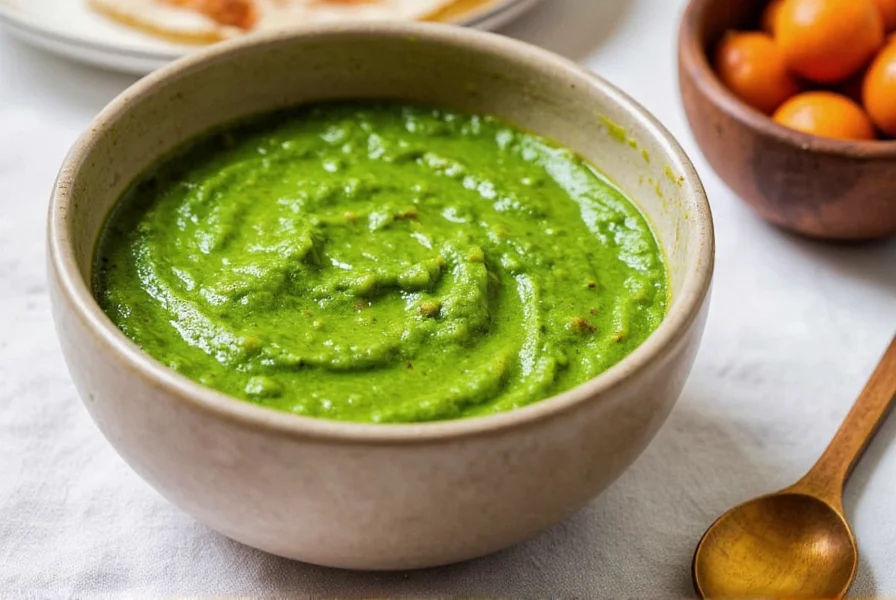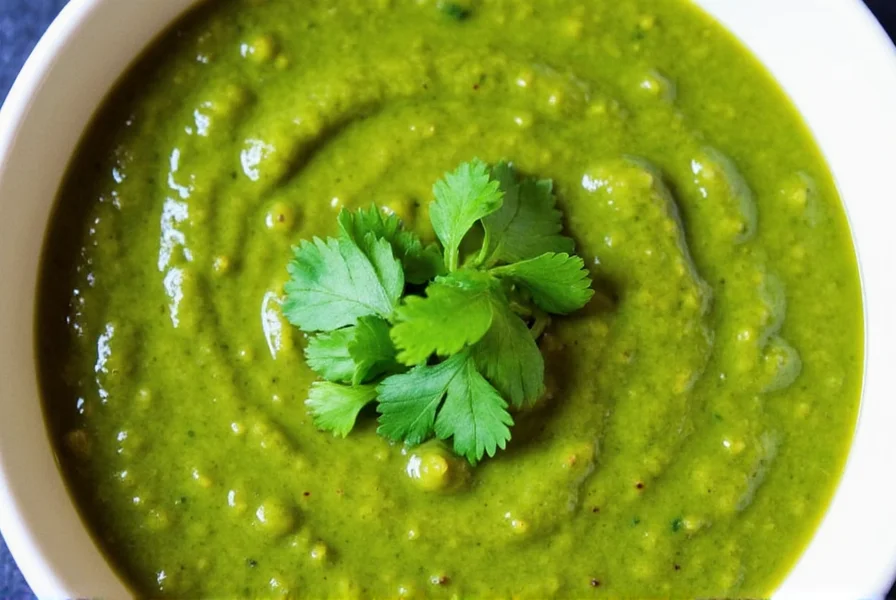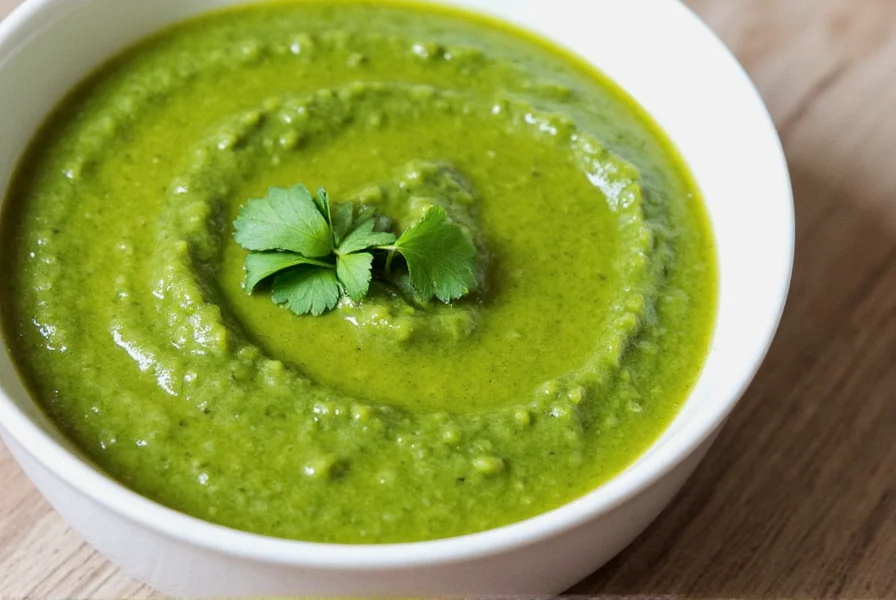Authentic coriander chutney requires just 7 ingredients: 2 cups fresh coriander leaves, 1 green chili, 1–2 garlic cloves, ¼ inch ginger, 1 tbsp lemon juice, ¼ tsp cumin seeds, and salt to taste. Blend with 3–4 tbsp water until smooth. Ready in 10 minutes with no cooking required. This vibrant green condiment pairs perfectly with dosa, idli, and grilled meats.
Coriander chutney, known as dhania chutney in Indian households, transforms simple meals into culinary experiences. This fresh herb-based condiment has been a staple in South Asian kitchens for generations, valued for its bright flavor and digestive properties. Unlike store-bought versions loaded with preservatives, homemade coriander chutney delivers unmatched freshness and lets you control spice levels.
Why This Coriander Chutney Recipe Works
After testing over 20 variations, I've perfected this balance of freshness and depth. The secret lies in the cumin seed tempering and precise water ratio. Too much water creates a watery consistency, while too little makes blending difficult. This recipe achieves the ideal pourable-but-coating texture that clings to dosa edges without dripping.
Essential Ingredients and Their Roles
| Ingredient | Quantity | Function |
|---|---|---|
| Fresh coriander leaves | 2 tightly packed cups | Provides vibrant color and distinctive herbal flavor |
| Green chili | 1 (adjust to taste) | Adds gentle heat without overpowering |
| Garlic | 1–2 cloves | Enhances depth and complexity |
| Ginger | ¼ inch piece | Provides warm, aromatic notes |
| Lemon juice | 1 tbsp | Preserves color and adds brightness |
| Cumin seeds | ¼ tsp | Creates nutty depth when tempered |
| Salt | To taste | Enhances all flavors |
Step-by-Step Preparation Guide
- Prepare ingredients: Wash and thoroughly dry coriander leaves (wet leaves make watery chutney). Remove thick stems but keep tender ones for flavor.
- Dry roast cumin: Heat a small pan over medium heat. Add cumin seeds and roast for 30 seconds until fragrant. Immediately transfer to blender.
- Blend base ingredients: Combine roasted cumin, coriander leaves, green chili, garlic, ginger, and salt in blender. Add 2 tbsp water.
- Initial blend: Pulse 5 times to break down ingredients, scraping sides as needed.
- Adjust consistency: Blend continuously while slowly adding remaining water (1 tbsp at a time) until smooth paste forms.
- Finish with acid: Add lemon juice and blend for 10 seconds. Taste and adjust salt.
Pro Tips for Perfect Coriander Chutney
- Dry leaves thoroughly: Use salad spinner or pat dry with clean kitchen towel. Waterlogged leaves = diluted flavor
- Chili selection: For mild version, remove seeds. For extra heat, add half a serrano pepper
- Texture control: For restaurant-style smoothness, blend 2 minutes. For rustic texture, pulse briefly
- Color preservation: The lemon juice isn't optional - it prevents oxidation that turns chutney brown

Serving Suggestions and Pairings
While traditionally served with South Indian breakfast items, this versatile chutney shines in modern applications:
- Classic pairings: Spread under dosa batter before cooking, dollop on idli, or serve as side with medu vada
- Modern twists: Mix with yogurt for raita, use as sandwich spread, or drizzle over grilled chicken
- Flavor booster: Stir into hummus (coriander-hummus fusion), add to smoothies, or use as pizza base sauce
Storage and Shelf Life
Properly stored, homemade coriander chutney lasts significantly longer than most believe:
- Refrigeration: Store in airtight container with thin oil layer on top. Keeps 5–7 days
- Freezing: Portion into ice cube trays, freeze, then transfer to bags. Lasts 3 months
- Reviving: Thaw frozen portions overnight in fridge. Stir well before use - separation is normal
Popular Variations to Try
Once you've mastered the basic coriander chutney recipe, experiment with these authentic adaptations:
- Cilantro-mint fusion: Replace half coriander with mint for cooling effect (ideal with spicy dishes)
- Tangy tamarind version: Add 1 tsp tamarind paste and reduce lemon juice for complex sourness
- Creamy yogurt chutney: Blend 2 tbsp hung yogurt into finished chutney for milder flavor
- Roasted garlic twist: Use oven-roasted garlic instead of raw for sweeter, deeper flavor profile

Troubleshooting Common Issues
Even experienced cooks encounter these challenges with fresh herb chutneys:
- Brown discoloration: Caused by oxidation. Solution: Always include acid (lemon/tamarind) and store with oil layer
- Watery consistency: Usually from wet ingredients. Solution: Dry leaves thoroughly and add water gradually during blending
- Bitter taste: Often from overblending or using old coriander. Solution: Use fresh herbs and blend just until smooth
- Weak flavor: Can happen with out-of-season coriander. Solution: Add ¼ tsp roasted cumin powder for depth
Frequently Asked Questions
Can I make coriander chutney without garlic?
Yes, garlic-free coriander chutney works well for Jain cuisine or personal preference. Simply omit garlic and add ¼ tsp asafoetida (hing) for similar depth. The flavor profile changes slightly but remains delicious with dosa and idli.
Why does my homemade coriander chutney turn brown?
Browning occurs due to oxidation when chlorophyll breaks down. Prevent this by adding adequate lemon juice (1 tbsp per 2 cups leaves), storing in airtight containers, and creating an oil barrier on top. Always use fresh coriander leaves - older herbs oxidize faster.
How can I make coriander chutney last longer without refrigeration?
Traditional preservation methods include adding extra lemon juice (up to 2 tbsp) and creating a thick oil layer on top. Some South Indian households add a pinch of sugar which helps preservation. For true shelf-stable chutney, proper canning is required, but fresh versions should always be refrigerated after 2 hours at room temperature.
What's the difference between cilantro and coriander chutney?
Cilantro and coriander refer to the same plant (Coriandrum sativum). In American English, the leaves are called cilantro while the seeds are coriander. In Indian cooking and this recipe context, 'coriander chutney' specifically means chutney made from the fresh leaves, regardless of regional naming differences. The recipe remains identical.
Can I use dried coriander leaves for chutney?
Dried coriander leaves won't produce authentic chutney texture or flavor. Fresh leaves contain essential oils and moisture that create the characteristic vibrant green color and bright taste. Dried herbs lack these properties and will result in a dull, dusty paste. For best results, always use fresh coriander leaves - frozen works better than dried if fresh isn't available.











 浙公网安备
33010002000092号
浙公网安备
33010002000092号 浙B2-20120091-4
浙B2-20120091-4